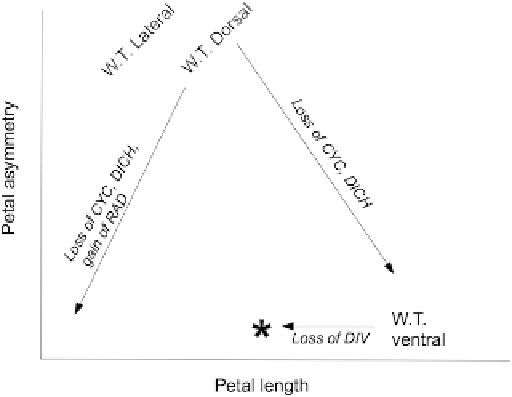Biology Reference
In-Depth Information
complicated and can involve subjective judgement, especially about the extent to which
details should be omitted to leave a relatively simple underlying programme of change.
Once the programme of transformations has been determined, two things can be done
with it. The first is a simple verification that, in a computer model, subjecting a starting
tissue to the transformation programme does indeed produce something that looks like
normal development.
82
The second is to try to correlate the types of transformation, and
especially sudden changes in transformation rules, with molecular changes in the cells
or with the very local expression of particular genes. An example is the local expression
of a set of genes in the dorsal and ventral domains of developing Antirrhinum majus
('snap-dragon'). The flowers have four petals, which join to make a tube in the heart of
the flower, but which separate into distinct petals at the flower's opening. The petals are
of three types: one dorsal petal, one ventral petal and two lateral petals. A zone in the
dorsal part of the flower normally expresses three transcription factors: CYC, DICH and
RAD. RAD restricts the expression of another transcription factor, DIV, to a zone in the
ventral part of the flower. These zones are at the correct points to act as the reference point
for the transformations that yield the morphogenesis of each petal type.
83
Some features of
the programme of transformations (for example a constant axis of main growth) can also be
used to imply the existence of long-range signals for which experimental botanists can then
search.
84
The approach of building transformation models of growth can also be used for analysis of
mutants. The shapes of Antirrhinum petals can be summarized
d
at least from the point
of view of measuring expressing a phenotype quantitatively
d
by plotting them on a graph
of length against asymmetry; on this graph, petals of wild-type flowers occupy distinct zones
(
Figure 22.15
). If the dorsally expressed transcription factors CYC and DICH are mutated so
that their function is lost, the dorsal petal lengthens, loses it asymmetry and becomes very
FIGURE 22.15
Effect of mutations on the shapes of petals in Antirrhinum major: the graph summarizes some of
the data in Kuchen et al.
85


